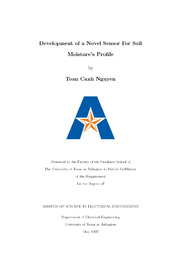
ATTENTION: The works hosted here are being migrated to a new repository that will consolidate resources, improve discoverability, and better show UTA's research impact on the global community. We will update authors as the migration progresses. Please see MavMatrix for more information.
Show simple item record
| dc.contributor.advisor | Tjuatja, Saibun | |
| dc.creator | Nguyen, Toan Canh | |
| dc.date.accessioned | 2022-06-28T15:10:59Z | |
| dc.date.available | 2022-06-28T15:10:59Z | |
| dc.date.created | 2022-05 | |
| dc.date.issued | 2022-05-05 | |
| dc.date.submitted | May 2022 | |
| dc.identifier.uri | http://hdl.handle.net/10106/30378 | |
| dc.description.abstract | Monitoring of soil’s water content has been an important part of the irrigation system in farming, regional resources development, rainfall detection as well as
disaster prevention. There has been studies and developments in this area over the
decades. However, most of the works are focused on sensing the soil as a homogeneous medium, which does not accurately reflect the heterogeneous structure of soil.
Works on multi-layer soil sensing have been researched and developed. Though, the
current design is complex, not easy to produce and assemble. This work presents
a novel low-cost and simple soil sensor design to detect the soil’s water content at
different layers. The design is capacitive approach. In this method, soil acts as
the medium whose dielectric values vary with its water content. These changes result in shifts in resonant frequencies of the sensor’s structure, which can be used
to determine the water content of the soil. This sensing approach is simple, inexpensive, easy to set up and portable. For soil profile sensing purposes, the soil
depth’s information is encoded in the sensor’s physical structure. Instead of using
a rectangular plate, the sensor’s shape is varied exponentially. As the capacitive
effect depends on the area of the conductor, this design allows for more changes in
soil profile to be captured. A theoretical model for this sensor design was developed
with Transmission Line and ABCD Network in MATLAB. A similar model was set
up in High-Frequency Simulation Software (HFSS) for comparison. The deign was
tested in medium which consists of two different soil profiles. The boundary between
the two profiles varied along the length of the sensor. The results in theoretical and
simulating model showed corresponding changes in resonant frequencies as the soil
boundary changes in three different cases. A lab measurement was arranged to compare the performance of this proposed design (exponential shape) with the standard
one (rectangular shape). This setup was also modeled in simulating software for
comparison. The results showed that proposed sensor design had higher sensitivity
when the boundary layer varied toward end of the sensor. Finally, the effect of the
proposed sensor design’s parameter was studied in HFSS and the design for the
sensor was finalized to achieve the highest sensitivity. | |
| dc.format.mimetype | application/pdf | |
| dc.language.iso | en_US | |
| dc.subject | Profile sensing | |
| dc.subject | FDR sensor | |
| dc.title | Development of a Novel Sensor For Soil Moisture's Profile | |
| dc.type | Thesis | |
| dc.degree.department | Electrical Engineering | |
| dc.degree.name | Master of Science in Electrical Engineering | |
| dc.date.updated | 2022-06-28T15:10:59Z | |
| thesis.degree.department | Electrical Engineering | |
| thesis.degree.grantor | The University of Texas at Arlington | |
| thesis.degree.level | Masters | |
| thesis.degree.name | Master of Science in Electrical Engineering | |
| dc.type.material | text | |
Files in this item
- Name:
- NGUYEN-THESIS-2022.pdf
- Size:
- 6.745Mb
- Format:
- PDF
This item appears in the following Collection(s)
Show simple item record


